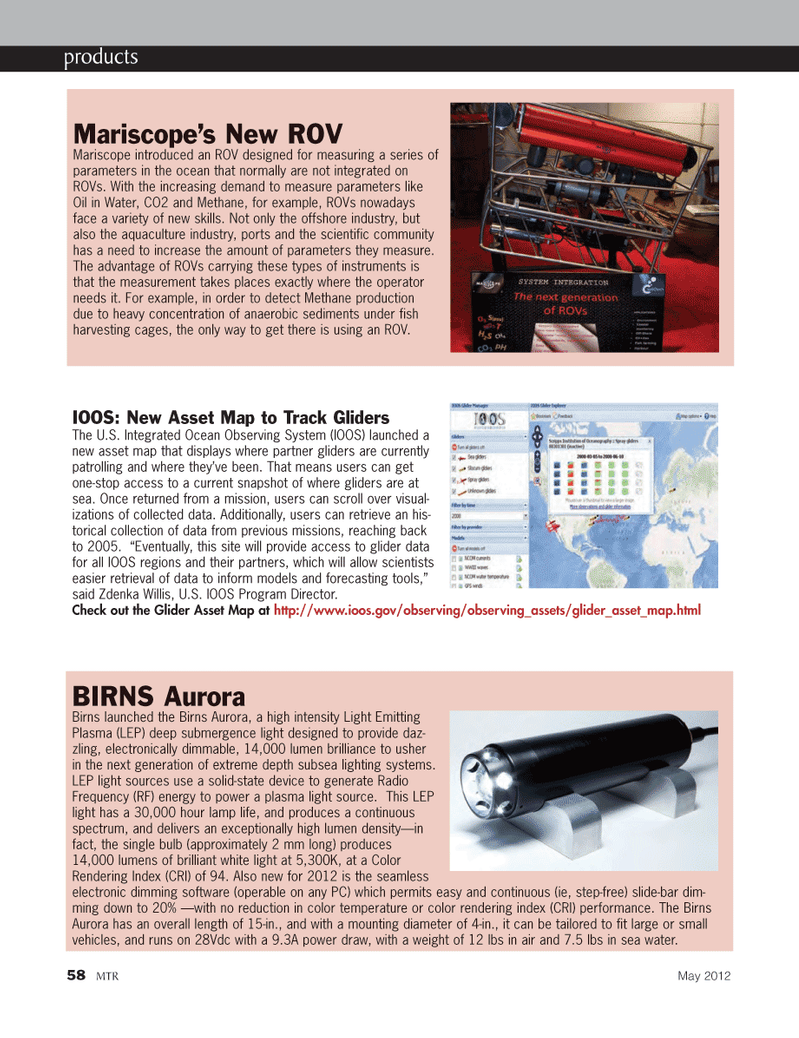
Page 58: of Marine Technology Magazine (May 2012)
Hydrographic Survey
Read this page in Pdf, Flash or Html5 edition of May 2012 Marine Technology Magazine
58MTRMay 2012products Mariscope?s New ROV Mariscope introduced an ROV designed for measuring a series of parameters in the ocean that normally are not integrated on ROVs. With the increasing demand to measure parameters like Oil in Water, CO2 and Methane, for example, ROVs nowadays face a variety of new skills. Not only the offshore industry, but also the aquaculture industry, ports and the scientific community has a need to increase the amount of parameters they measure. The advantage of ROVs carrying these types of instruments isthat the measurement takes places exactly where the operator needs it. For example, in order to detect Methane production due to heavy concentration of anaerobic sediments under fish harvesting cages, the only way to get there is using an ROV. IOOS: New Asset Map to Track Gliders The U.S. Integrated Ocean Observing System (IOOS) launched anew asset map that displays where partner gliders are currently patrolling and where they?ve been. That means users can get one-stop access to a current snapshot of where gliders are at sea. Once returned from a mission, users can scroll over visual- izations of collected data. Additionally, users can retrieve an his- torical collection of data from previous missions, reaching back to 2005. ?Eventually, this site will provide access to glider data for all IOOS regions and their partners, which will allow scientists easier retrieval of data to inform models and forecasting tools,? said Zdenka Willis, U.S. IOOS Program Director. Check out the Glider Asset Map at http://www.ioos.gov/observing/observing_assets/glider_asset_map.html BIRNS Aurora Birns launched the Birns Aurora, a high intensity Light Emitting Plasma (LEP) deep submergence light designed to provide daz- zling, electronically dimmable, 14,000 lumen brilliance to usher in the next generation of extreme depth subsea lighting systems. LEP light sources use a solid-state device to generate Radio Frequency (RF) energy to power a plasma light source. This LEP light has a 30,000 hour lamp life, and produces a continuous spectrum, and delivers an exceptionally high lumen density?infact, the single bulb (approximately 2 mm long) produces 14,000 lumens of brilliant white light at 5,300K, at a ColorRendering Index (CRI) of 94. Also new for 2012 is the seamlesselectronic dimming software (operable on any PC) which permits easy and continuous (ie, step-free) slide-bar dim- ming down to 20% ?with no reduction in color temperature or color rendering index (CRI) performance. The Birns Aurora has an overall length of 15-in., and with a mounting diameter of 4-in., it can be tailored to fit large or small vehicles, and runs on 28Vdc with a 9.3A power draw, with a weight of 12 lbs in air and 7.5 lbs in sea water. MTR#4 (50-64):MTR Layouts 5/7/2012 9:08 AM Page 58

 57
57

 59
59
